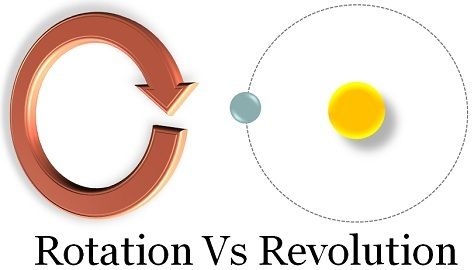 The motion along a curved path is termed as circular motion, like the orbital motion of planets, ice skater, blades of the fan, gears, amusement park rides, etc. The two fundamental concepts which are studied in circular motion are rotation and revolution. While rotation means the movement in a circle round an axis, revolution is when an object moves in a circular path around another object or center.
The motion along a curved path is termed as circular motion, like the orbital motion of planets, ice skater, blades of the fan, gears, amusement park rides, etc. The two fundamental concepts which are studied in circular motion are rotation and revolution. While rotation means the movement in a circle round an axis, revolution is when an object moves in a circular path around another object or center.
Many people often misinterpret these two concepts as they think that these two are same. But this is not so, as they differ from one another in the sense that rotation does not change the position of the object, but revolution does. So, here we’ve explained the difference between rotation and revolution in detail, take a read.
Content: Rotation Vs Revolution
Comparison Chart
| Basis for Comparison | Rotation | Revolution |
|---|---|---|
| Meaning | Rotation refers to a circular motion around an axis, located within the body of the object. | Revolution means a circular motion around an axis, located outside the object. |
| What is it? | Movement of an object on its axis. | A complete round trip around something. |
| Axis | Internal | External |
| Change in position | No | Yes |
| Earth | Rotation of earth, is from west to east, which causes day and night. | Revolution of earth is in counterclockwise manner, which causes seasons. |
| Example | Hand of clocks, Spinning top, etc. | Rounding a curve in a car, merry go round etc. |
Definition of Rotation
The term ‘rotation’ is defined as the movement of an object, in a circular manner, about a certain point, i.e. turn around, its own axis. There exist an imaginary line known as the rotational axis around which a three-dimensional object rotates.
In the rotation, every point makes a circle around the central point. So, there is an equal distance from the center to any point of the shape. It is expressed in terms of degrees, wherein when the rotation is performed clockwise, the degrees is negative, while an anticlockwise rotation, will result in positive degrees.
The most popular example of rotation is the earth’s rotation, which takes approximately 24 hours to complete it, causing day and night.
Definition of Revolution
The term ‘revolution’ is used to describe a motion, wherein an object moves in a circular direction around an object or centre, in a fixed path or orbit. It involves travelling around an axis outside the object, i.e. external axis.
The distance traveled by an object, in one revolution, around the circle, is nothing but its circumference. The time taken by an object to complete one revolution around the circle is known as the period, represented by T.
The revolution of the Earth around the Sun is in an anticlockwise manner, which takes 365 days and 6 hours to complete. It is the only reason for causing seasons to change.
Key Difference Between Rotation and Revolution
The difference between rotation and revolution can be drawn clearly on the following grounds:
- A circular motion around an axis, located within the body of the object, is called rotation. A circular motion around an axis, located outside the object, is called a revolution.
- Rotation is the movement of an object on its own axis. On the other hand, revolution is the complete round trip around something, i.e. another object or center.
- Rotation is when the object spins around an internal axis. Conversely, revolution is when the object travels around an external axis.
- In the rotation, the object moves around its axis, without changing its position. As against this, in the revolution, the object moves along an elliptical course, with a continuous change in its position.
- Earth’s rotation is from the west towards the east, which it completes in approx. 24 hours. But, the revolution of the Earth around the Sun is in a counterclockwise manner when you are looking at it from a North direction, i.e. from the North Pole i.e. west to east., which is completed in around, 365 days.
- Common examples of rotation are the hand of clocks, spinning top, etc. In contrast, the common examples of revolution are rounding a curve in a car, kids merry go round, etc.
Conclusion
Therefore, with the above discussion, you might have gained ample knowledge about the two terms, and will not get confused between them in future. While rotation means spinning around its own axis, revolution means moving around another object. Taking the example of the Earth, which rotates 366 times to complete one revolution around the Sun.






Love Puppys says
I LOVE IT.
Torpine Teryila kelvin says
It’s very interesting
trani says
Great Job! My kids learned a lot because they are in intermidiate
ELLA says
THANK YOU THIS WEBSITE HELPED ME IN MY SCHOOL WORK WELL
Joy Iordye says
Wow, lovely
McMalanko noble mbame dominic says
Extraordinary and amazing post
Ben Dover says
Thank you, this changed my life.
Aniffy says
Very useful for students to learn geography easily
Ptil kayam says
Thank you it help love it